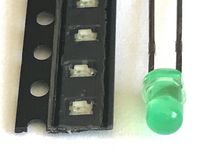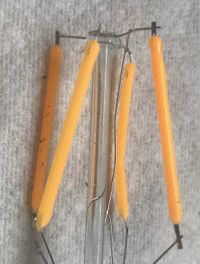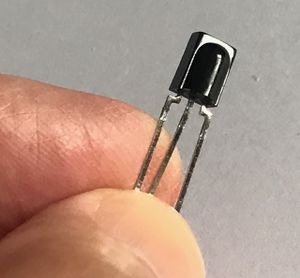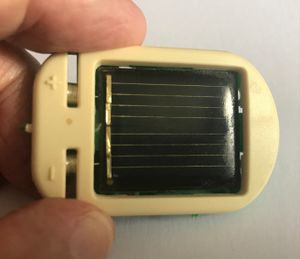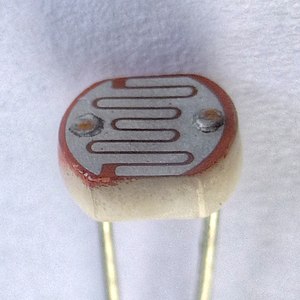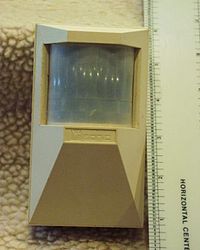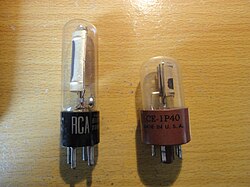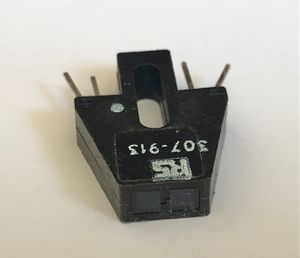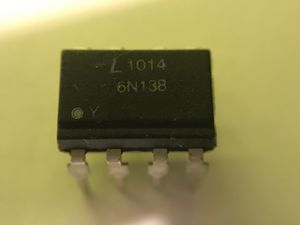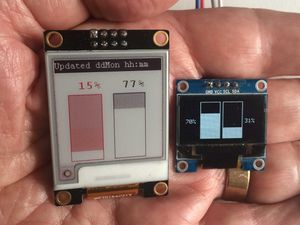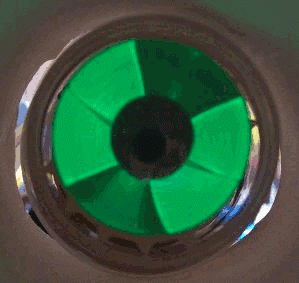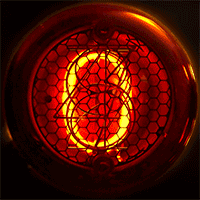Optoelectronic components: Difference between revisions
(→OLED) |
|||
| (15 intermediate revisions by the same user not shown) | |||
| Line 1: | Line 1: | ||
This page covers components which emit or detect light, or change their appearance under the control of an electrical input: how to recognise them and understand | This page covers components which emit, use or detect light, or change their appearance under the control of an electrical input: how to recognise them and understand what they might be doing. | ||
<div class="showtoc"> | <div class="showtoc"> | ||
__TOC__ | __TOC__ | ||
| Line 5: | Line 5: | ||
==Summary== | ==Summary== | ||
Of all our senses, sight is our richest source of information about the world around us. Naturally, then, this is often the best way in which electronic devices can communicate with us. This can be using simple indicator lights through to highly complex large format | Of all our senses, sight is our richest source of information about the world around us. Naturally, then, this is often the best way in which electronic devices can communicate with us. This can be using simple indicator lights through to highly complex large format display screens, and can embody several different technologies. Conversely, our gadgets often need to detect light, whether just to sense when a beam has been interrupted for example by closing a lid, or in order to image a scene as in a camera. Again, several principles are used across different devices. | ||
In total, this amounts to a fair number of different types of component, but it's generally easy to identify them, to understand what they're supposed to be doing, and whether they are indeed doing it. | In total, this amounts to a fair number of different types of component, but it's generally easy to identify them, to understand what they're supposed to be doing, and whether they are indeed doing it. | ||
| Line 19: | Line 19: | ||
Battery operated torches and bicycle lights once exclusively used small low voltage filament bulbs with a screw base and somewhat larger 12V versions were used in cars. | Battery operated torches and bicycle lights once exclusively used small low voltage filament bulbs with a screw base and somewhat larger 12V versions were used in cars. | ||
You may still sometimes come across small low voltage filament bulbs, either with a screw base, or wire-ended and only a few | You may still sometimes come across small low voltage filament bulbs, either with a screw base, or wire-ended and only a few millimetres in diameter illuminating the dial in an older radio or alarm clock. Until displaced by LEDs, they were extremely commonly used as Christmas tree lights with many low voltage bulbs in [[Glossary:Series|series]] adding up to the mains voltage of 240V. | ||
===Neon bulbs=== | ===Neon bulbs=== | ||
[[File:AC powered NE-2 type neon lamp close-up.jpg|thumb|150px|right|A neon lamp. Both electrodes are glowing since it is being operated from AC.]] | [[File:AC powered NE-2 type neon lamp close-up.jpg|thumb|150px|right|A neon lamp. Both electrodes are glowing since it is being operated from AC.]] | ||
Before LEDs became cheap and common, a neon bulb would very often be used as a power-on indicator. A common form consists of two electrodes sealed inside a 5mm glass tube containing a trace of neon gas. When lit, it gives a gently orange glow. Other | Before LEDs became cheap and common, a neon bulb would very often be used as a power-on indicator. A common form consists of two electrodes sealed inside a 5mm glass tube containing a trace of neon gas. When lit, it gives a gently orange glow. Other colours are sometimes seen, in particular green. These either use a different gas which naturally glows green, or a gas producing blue and ultraviolet with a phosphor coating inside the glass which glows with the required colour. | ||
Neon bulbs may require over 100V in order to light, but then operate at a voltage of around 30% less. With the added fact that they work equally with [[Glossary:AC|AC]] or [[Glossary:DC|DC]], they are very easy to operate from the mains. All you need is a 1MΩ resistor in series to limit the current. On no account must this be omitted! | Neon bulbs may require over 100V in order to light, but then operate at a voltage of around 30% less. With the added fact that they work equally with [[Glossary:AC|AC]] or [[Glossary:DC|DC]], they are very easy to operate from the mains. All you need is a 1MΩ resistor in series to limit the current. On no account must this be omitted! | ||
===LEDs=== | ===LEDs=== | ||
[[File:Standard ad 3mm LEDs.jpg|thumb| | [[File:Standard ad 3mm LEDs.jpg|thumb|200px|left|A standard 3mm LED and a strip of surface mount LEDs in the manufacturer's packaging.]] | ||
[[File:LED filament.jpg|thumb|200px|right|LED filaments from a broken LED lamp.]] | |||
LEDs or Light Emitting Diodes have become ubiquitous since they first appeared in the 1970's. For many years only infrared, red and green were available, with the first practical blue LEDs appearing only in the 1990's, followed by violet and ultraviolet. LEDs are essentially no different from other semiconductor [[Glossary:Diode|diodes]] except that instead of (most often) silicon, they use semiconductor materials with particular quantum mechanical properties causing the energy lost by electrons passing through them in a forward direction to be released as photons of light rather than as heat. | LEDs or Light Emitting Diodes have become ubiquitous since they first appeared in the 1970's. For many years only infrared, red and green were available, with the first practical blue LEDs appearing only in the 1990's, followed by violet and ultraviolet. LEDs are essentially no different from other semiconductor [[Glossary:Diode|diodes]] except that instead of (most often) silicon, they use semiconductor materials with particular quantum mechanical properties causing the energy lost by electrons passing through them in a forward direction to be released as photons of light rather than as heat. | ||
LEDs | LEDs (in common with other forms of diode) do not obey Ohm's Law (which states that as you increase the voltage, the current increases in exact proportion). In a diode, by contrast, the current increases exponentially with voltage. To prevent it burning out a LED is almost always wired in [[Glossary:Series|series]] with a [[Glossary:Resistor|resistor]] (which does obey Ohm's Law) to limit the current. | ||
In COB (or Chip On Board LEDS | LEDs come in many different forms. As electronic components, the 3 or 5mm clear or coloured packages are most familiar but other shapes and sizes are available. Sometimes these contain 2 or 3 LED chips emitting different colours and with up to 4 wires, allowing different colour combinations to be produced. Much smaller surface mount LEDs are often found on circuit boards adjacent to a lens or light pipe allowing their glow to be seen on the outside of an appliance. | ||
In COB (or Chip On Board) LEDS, several or many blue LED chips are mounted directly on a circuit board and covered with a phosphor which converts the blue to white light. In "filament" LED light bulbs the LED chips are mounted on a thin flexible strip, sometimes bent into a helix or other shape for aesthetic effect. | |||
===Lasers diodes=== | ===Lasers diodes=== | ||
[[File:Diode laser.jpg|thumb|right|A diode laser.]] | [[File:Diode laser.jpg|thumb|right|A diode laser.]] | ||
There are many types of laser but their defining property is that they produce light in which all the light waves are lined up perfectly into a single beam. Think of the single continuous tone produced by an organ pipe as opposed by the hissing sound of an escape of high | There are many types of laser but their defining property is that they produce light in which all the light waves are lined up perfectly into a single beam. Think of the single continuous tone produced by an organ pipe as opposed by the hissing sound of an escape of high pressure air. | ||
An LED can be specially constructed so that much of the light bounces back and forth between two reflecting surfaces like sound in an organ pipe. Fed with a sufficiently large current, this can produce laser light instead of the disorganised light that a LED normally produces as electrons pass randomly through it. | An LED can be specially constructed so that much of the light bounces back and forth between two reflecting surfaces like sound in an organ pipe. Fed with a sufficiently large current, this can produce laser light instead of the disorganised light that a LED normally produces as electrons pass randomly through it. | ||
| Line 51: | Line 54: | ||
A junction transistor consists essentially of two diodes in close proximity such that a small current passing through one allows a much larger current to flow through the other. Exposed to light, this is equivalent to a photodiode connected to a transistor to amplify the photodiode's current. | A junction transistor consists essentially of two diodes in close proximity such that a small current passing through one allows a much larger current to flow through the other. Exposed to light, this is equivalent to a photodiode connected to a transistor to amplify the photodiode's current. | ||
Two transistors can be connected in a "[[wikipedia:Darlington_transistor|Darlington pair]]" in which the second transistor further amplifies the current from the first. If the first is a photo-transistor the result is a darlington photo-transistor with still greater sensitivity. When designed to receive the signal | Two transistors can be connected in a "[[wikipedia:Darlington_transistor|Darlington pair]]" in which the second transistor further amplifies the current from the first. If the first is a photo-transistor the result is a darlington photo-transistor with still greater sensitivity. When designed to receive the signal from an infrared remote there may be additional circuitry integrated with the photo-transistor in order to shape and conditional the signal ready for decoding. | ||
===Photovoltaic cells=== | |||
[[File:Small PV cell.jpg|thumb|right|A small photovoltaic cell from a solar-powered toy.]] | |||
Solar, or more correctly photovoltaic or PV cells have become increasingly familiar in recent years, first appearing in solar-powered calculators then as solar garden lights, and more recently as large solar panels mounted on roofs. Considerable improvements in efficiency have been made, driven by the current emphasis on carbon-free energy. | |||
Any diode will in fact generate a small voltage if light is shone on it, but most are housed in opaque packages and not optimised for this mode of operation. Try connecting a multimeter on a 2V range to a LED (green or blue will probably work best) and placing it in a bright light. | |||
Silicon PV cells only generate about half a volt per cell and so are connected several or many in [[Glossary:Series|series]] to give a workable output. In fact the level of illumination makes little difference to the voltage but does affect the amount of current it will deliver. Consequently, solar arrays are normally used with a Maximum Power Point or MPP controller which continually monitors the array in order to draw the maximum power, stepping the voltage up or down to that required to charge a battery or feed into the grid. | |||
===Light-dependant resistors (LDRs)=== | ===Light-dependant resistors (LDRs)=== | ||
| Line 57: | Line 68: | ||
A Light Dependant or Photo Resistor uses a semiconductor such as cadmium sulphide which, in the dark, has few electrons free to carry a current and so has a high resistance. If you shine a light on it, more electrons are released and so its resistance is reduced. Unlike a photodiode, it's a pure resistance, conducting equally in either direction. | A Light Dependant or Photo Resistor uses a semiconductor such as cadmium sulphide which, in the dark, has few electrons free to carry a current and so has a high resistance. If you shine a light on it, more electrons are released and so its resistance is reduced. Unlike a photodiode, it's a pure resistance, conducting equally in either direction. | ||
The use of cadmium is now restricted on account of its toxicity and so LDRs are most likely to be found in older equipment. They were frequently used in photographic light meters, to control street lights, night lights and the brightness of a digital clock with a LED-based 7-segment display. They have also been used in musical equipment. Some kind of vane actuated by a foot pedal controls the amount of light from a lamp falling on an LDR, which in turn controls the volume or other characteristic of the music. This avoids any crackling that a [[Glossary:Potentiometer|potentiometer]] used for this | The use of cadmium is now restricted on account of its toxicity and so LDRs are most likely to be found in older equipment. They were frequently used in photographic light meters, to control street lights, night lights and the brightness of a digital clock with a LED-based 7-segment display. They have also been used in musical equipment. Some kind of vane actuated by a foot pedal controls the amount of light from a lamp falling on an LDR, which in turn controls the volume or other characteristic of the music. This avoids any crackling that a [[Glossary:Potentiometer|potentiometer]] used for this purpose might produce after heavy use. | ||
===PIR detectors=== | ===PIR detectors=== | ||
[[File:Front-Fresnel type.JPG|thumb|200px|right|A PIR detector]] | [[File:Front-Fresnel type.JPG|thumb|200px|right|A PIR detector]] | ||
Passive Infra-Red or PIR detectors work on a principle related to the piezoelectric effect, in which a strain applied to certain types of crystal slightly displaces the positive and negative charges within it, creating a net voltage across opposite faces. In the pyroelectric effect, this strain is produced by the very slight warming produced by infrared (heat) radiation. In a PIR detector, a number of plastic lenses formed | Passive Infra-Red or PIR detectors work on a principle related to the piezoelectric effect, in which a strain applied to certain types of crystal slightly displaces the positive and negative charges within it, creating a net voltage across opposite faces. In the pyroelectric effect, this strain is produced by the very slight warming produced by infrared (heat) radiation. In a PIR detector, a number of plastic lenses formed in a single piece of transparent plastic are placed in front of a pyroelectric sensor causing multiple images of a warm body (a person, an animal or a vehicle) to move across the sensor as it moves across the field of view. In fact there may be two sensors with the detector designed to detect differences between their outputs, reducing false detections which might be caused by environmental or electrical effects affecting both equally. | ||
===Vacuum photocells=== | |||
[[File: Phototubes.jpg |thumb|250px|right|Vacuum photocells]] | |||
The vacuum photocell is earliest form of light detector, invented in the late 19th Century. It consists of a half-cylinder of a metal from which [[Glossary:Electron|electrons]] are easily ejected (the photocathode), and a metal rod (the anode) mounted along its axis. The whole is enclosed in a sealed glass tube in a vacuum or with a gas at low pressure. Light falling on the photocathode ejects electrons, some of which fall on the anode or are attracted to it by a positive applied voltage. This constitutes a small electric current proportional the intensity of the light. | |||
Very early on it was observed that, surprisingly, the energy with which electrons were ejected from the photocathode was completely independent of the intensity of the light, but depended only on its colour. From this, in 1905 Albert Einstein deduced that light consists of discrete quanta of energy, so laying the foundation for Quantum Mechanics and earning him a Nobel Prize in 1921. | |||
===Photomultipliers=== | |||
[[File:Pmside.jpg|thumb|150px|right|A photomultiplier tube]] | |||
Today, vacuum photocells have been completely superseded by photodiodes, phototransistors and light-dependant resistors | |||
except as the light-sensitive element in a photomultiplier tube. | |||
In a photomultiplier, electrons ejected from a photocathode are attracted to an intermediate anode known as a dynode, held at a voltage of perhaps 100V. Accelerated by this voltage, each electron strikes the dynode with sufficient energy to eject maybe 10 electrons. These are attracted to another dynode held at 200V resulting now in a cascade of maybe 100 electrons. A whole sequence of dynodes, each held at a higher voltage still gives a multiplication of as much as 100,000 from each initial electron. Suitably configured, a photomultiplier can detect individual [[Glossary:Photon|photons]] striking it. So sensitive is it that under power, it would probably be destroyed if you shone enough light on it to see it by. | |||
Unlike vacuum photocells, photomultipliers are still very much in use today especially in scientific applications. This is due to their extreme sensitivity, unmatched by any other device, and their relatively large light-collecting area. | |||
==Optical sensors== | ==Optical sensors== | ||
[[File:Reflective infrared sensor.jpg|thumb|right|A reflective infrared sensor. ]] | [[File:Reflective infrared sensor.jpg|thumb|right|A reflective infrared sensor. ]] | ||
Optical sensors are often used to detect a mechanical condition, such | Optical sensors are often used to detect a mechanical condition, such as a lid being closed, a finger guard in place, a moving part being at the limit of its travel or the motion of a wheel. This can be done with a LED and a light detector such as a photodiode, phototransistor or photo Darlington, but for convenience, the two are often packaged together. Very often an infrared LED is used since photodiodes and their cousins have good sensitivity in the infrared. | ||
There are two types. In the reflective type the LED and light detector face the same way in order to detect a reflective surface in front of them. In a transmissive one, they face each other across a gap. These are very common in older mechanical mice, in which a wheel with slots in it is placed in the gap in order to sense its rotation as the mouse moves. | There are two types. In the reflective type the LED and light detector face the same way in order to detect a reflective surface in front of them. In a transmissive one, they face each other across a gap. These are very common in older mechanical mice, in which a wheel with slots in it is placed in the gap in order to sense its rotation as the mouse moves. | ||
There are other types of optical sensor for more specialised purposes, for example three light sensors covered by three different coloured filters can be used to determine a colour, or the colour temperature of | There are other types of optical sensor for more specialised purposes, for example three light sensors covered by three different coloured filters can be used to determine a colour, or the colour temperature of a light source or a scene. | ||
==Opto isolators== | ==Opto isolators== | ||
| Line 75: | Line 101: | ||
[[File:Opto-isolator.jpg|thumb|right|An opto isolator.]] | [[File:Opto-isolator.jpg|thumb|right|An opto isolator.]] | ||
Opto isolators commonly come as a 6 or 8 pin dual-inline package just like a simple [[Glossary:Integrated Circuit|IC]]. | Opto-isolators commonly come as a 6 or 8 pin dual-inline package just like a simple [[Glossary:Integrated Circuit|IC]]. | ||
Opto isolators are extremely common in [[Glossary:SMPS|switch mode power supplies]]. Isolation of the output power from the mains input is achieved with a transformer but feedback is required from the output to the input in order to regulate the power so as to produce a constant output voltage. If you look inside such a power supply you will find the transformer and an opto isolator both straddling a very clear demarcation on the board (often a physical slot) between all the circuitry directly fed from the mains and all the circuity feeding the output. | Opto-isolators are extremely common in [[Glossary:SMPS|switch mode power supplies]]. Isolation of the output power from the mains input is achieved with a transformer but feedback is required from the output to the input in order to regulate the power so as to produce a constant output voltage. If you look inside such a power supply you will find the transformer and an opto-isolator both straddling a very clear demarcation on the board (often a physical slot) between all the circuitry directly fed from the mains and all the circuity feeding the output. | ||
Musical instruments with a MIDI interface (allowing them to be connected to MIDI synthesisers, sequencers and other instruments) always contain an opto isolator on the MIDI input, as required by the MIDI interface specification. This eliminates the risk of ground loops - spurious currents flowing between different pieces of equipment, each with its own mains power supply. | Musical instruments with a MIDI interface (allowing them to be connected to MIDI synthesisers, sequencers and other instruments) always contain an opto-isolator on the MIDI input, as required by the MIDI interface specification. This eliminates the risk of ground loops - spurious currents flowing between different pieces of equipment, each with its own mains power supply. | ||
==Image sensors== | ==Image sensors== | ||
[[File:Ccd-sensor.jpg|thumb|right|An image | [[File:Ccd-sensor.jpg|thumb|right|An image sensor on a flexible circuit board.]] | ||
Until semiconductor image sensors started to appear in the 1990's, all TV and video cameras used vacuum tubes to capture images. Like an old fashioned [[Glossary:CRT|CRT]] (used in TVs before flat screens became available), these used a scanning electron beam to read out the brightness of the image at each point. There were various different types of [[wikipedia:Video_camera_tube|video camera tube]] but you are never likely to see any of them today outside a museum. | Until semiconductor image sensors started to appear in the 1990's, all TV and video cameras used vacuum tubes to capture images. Like an old fashioned [[Glossary:CRT|CRT]] (used in TVs before flat screens became available), these used a scanning electron beam to read out the brightness of the image at each point. There were various different types of [[wikipedia:Video_camera_tube|video camera tube]] but you are never likely to see any of them today outside a museum. | ||
All image sensors today consist | All image sensors today consist essentially of a large array of photodiodes fabricated on a single silicon chip. A colour image sensor will have separate photodiodes for each of the three primary colours. There are two types: | ||
* In CMOS sensors the pixels are read out by row and column in the same | * In CMOS sensors the pixels are read out by row and column in the same way as the pixels are addressed in a flat screen display. These are the cheaper sort and use the least power and hence are used in the majority of still cameras and webcams. | ||
* CCD or Charge Coupled Devices read out the data by passing a charge from each pixel along its row (or column) to the end, like a [[wikipedia:Bucket-brigade_device|bucket brigade]]. This requires less circuitry per pixel for the readout and hence allows more area for collecting light, and so is used in high end cameras. | * CCD or Charge Coupled Devices read out the data by passing a charge from each pixel along its row (or column) to the end, like a [[wikipedia:Bucket-brigade_device|bucket brigade]]. This requires less circuitry per pixel for the readout and hence allows more area for collecting light, and so is used in high end cameras. | ||
| Line 94: | Line 120: | ||
* 7-segment displays are very familiar as calculator displays. Each digit is formed by a unique combination of the 7 segments. 9 segments have sometimes been used. | * 7-segment displays are very familiar as calculator displays. Each digit is formed by a unique combination of the 7 segments. 9 segments have sometimes been used. | ||
* 14- and 16-segment displays allow alphanumeric data to be represented in a similar way. These and 7 segment displays may additionally include a decimal point. | * 14- and 16-segment displays allow alphanumeric data to be represented in a similar way. These and 7 segment displays may additionally include a decimal point. | ||
* Dot | * Dot matrix displays represent data graphically, ranging from simple devices representing a single line of alphanumeric characters by an 8x5 matrix of dots per character, up to high-end TV and computer screens with many millions of pixels. | ||
Of the many different technologies, some are of largely historical interest. | |||
===Electro-mechanical=== | |||
[[File:Split-flap display 2016-01-17.gif|thumb|right|An animation of how a split-flap display works]] | |||
Maybe it's cheating to include electro-mechanical displays but perhaps they can be allowed on the basis that there will usually be some electronics driving them. However, they are only really of historical interest today. | |||
In a flip clock, each digit uses 10 cards, each with the top of one digit on one side and the bottom of the next on the other. These are now often collectable items. | |||
Large display boards at major rail stations or airports have sometimes used the same principle. With 26 cards they can display text. Alternatively, a 7 segment display can be made with segments electrically actuated to show either black or white. A scoreboard using this principle can easily be made large enough to be seen from across a stadium, and unlike a display using LEDs, is easily seen even in the brightest sunlight. | |||
===LCD=== | ===LCD=== | ||
[[File:Casio W-59 digital watch.jpg|thumb|right|A digital | [[File:Casio W-59 digital watch.jpg|thumb|right|A digital watch with LCD display]] | ||
LCDs (or liquid crystal displays) depend on [[wikipedia:Polarization_(physics)|polarisation]] of light. Between two polarising filters, a special liquid rotates the plan of polarisation of the light passing through if subject to an electric field.Hence light can pass though only if the plane of polarisation is aligned with both filters. | LCDs (or liquid crystal displays) depend on [[wikipedia:Polarization_(physics)|polarisation]] of light. Between two polarising filters, a special liquid rotates the plan of polarisation of the light passing through if subject to an electric field. Hence light can pass though only if the plane of polarisation is aligned with both filters. | ||
Very often, as in a calculator display, the LCD is configured to be view from the front. With a | Very often, as in a calculator display, the LCD is configured to be view from the front. With a single polarising filter and a reflective layer at the back, a segment appears dark if the polarisation of light is twisted and hence unable to pass through the filter on its way out again. Other LCD displays have a back-light to allow them to be read in poor light. Laptop and LCD TV screens have a large back-light, and LCD projectors focus the light from a bulb through the LCD. Colour displays have separate LCD pixels for the three colours, each with a coloured filter. | ||
LCDs are activated by an electric field and don't | LCDs are activated by an electric field and don't require any current to flow through them. As a result, simple LCD displays are well suited to low power battery devices such as calculators and digital clocks and watches. | ||
===LED=== | ===LED=== | ||
| Line 111: | Line 144: | ||
===OLED=== | ===OLED=== | ||
Normal LEDs use a | Normal LEDs use a crystalline semiconductor material but certain organic materials can be made to emit light in the same way, albeit with lower efficiency. The principle of operation is not quite the same, but unfortunately a knowledge of quantum mechanics is required to understand the difference. | ||
[[File:E-ink and OLED displays.jpg|thumb|right|E-ink (left) and OLED (right) displays compared.]] | [[File:E-ink and OLED displays.jpg|thumb|right|E-ink (left) and OLED (right) displays compared.]] | ||
| Line 117: | Line 150: | ||
===E-ink=== | ===E-ink=== | ||
E-ink displays are familiar as the screens of many e-book readers. They have the | E-ink displays are familiar as the screens of many e-book readers. They have the advantage that once an image has been written to the display, no power is required to maintain it, though it may fade over period of months or more. Even more significantly, being purely reflective they can be read in bright light which would make any self-illuminated display hard to read. | ||
Electrophoretic displays, as used in most e-book readers, represent the commonest technology. There are variations, but typically the display contains oil with a black dye in which are suspended tiny white particles. These can be attracted to the front to show a white pixel by a voltage applied between electrodes on the front and back of the display. A disadvantage is that the display is slow to respond so not suitable for moving images. Also, they require a higher voltage to switch than used by digital circuits, so the display needs to include a voltage boost circuit. | |||
In addition to relatively large e-ink displays, smaller ones are available, some capable of | In addition to relatively large e-ink displays, smaller ones are available, some capable of displaying three colours such as black, white and red - useful for indicating a warning. | ||
Electrochromic displays represent a newer technology, operating quite differently. An applied voltage causes a reversible chemical change in a very thin polymer layer, causing it to change between black and white. The voltage required is compatible with most digital electronics, and power requirements for writing an image are very low. In addition, they can be mass-produced by printing several layers on a flexible backing. Expect to see them start to appear as smart labels on supermarket shelves, and even on individual items. | |||
===DMD=== | ===DMD=== | ||
A DMD or Digital Micromirror Device is often used as an alternative to a LCD in a data projector. It consists of a large number of tiny mirrors, one for each pixel, fabricated on a silicon chip. Each mirror can be | A DMD or Digital Micromirror Device is often used as an alternative to a LCD in a data projector. It consists of a large number of tiny mirrors, one for each pixel, fabricated on a silicon chip. Each mirror can be individually deflected electrically so as to reflect the light from the lamp either through the projection lens and onto the screen, or into a light sink, where it's absorbed. The brightness of each pixel is controlled by switching it on and off very rapidly, the "on" proportion of the time corresponding to the brightness required. A colour display is achieved by illuminating it with red, green and blue light in turn through a spinning colour wheel with three colour filters. | ||
A projector using a DMD is immediately recognisable. If you scan your eye rapidly across the screen you will see the red, blue and green images separating. | A projector using a DMD is immediately recognisable. If you scan your eye rapidly across the screen you will see the red, blue and green images separating. | ||
===Plasma=== | ===Plasma=== | ||
[[File:Plasma-display-composition.svg|thumb|right|Construction | [[File:Plasma-display-composition.svg|thumb|right|Construction of a plasma display.]] | ||
Plasma displays are largely obsolete, having been overtaken by LCD and OLED displays as these have improved, largely eliminating their advantage of high contrast. | Plasma displays are largely obsolete, having been overtaken by LCD and OLED displays as these have improved, largely eliminating their advantage of high contrast. | ||
| Line 139: | Line 174: | ||
[[File:Vacuum fluorescent 1.jpg|thumb|right|A vacuum fluorescent display.]] | [[File:Vacuum fluorescent 1.jpg|thumb|right|A vacuum fluorescent display.]] | ||
A derivative technology was later used in vacuum fluorescent displays, generally configured as 7 or 15 segment displays with individual segments turned on or off by control electrodes. Additional individually illuminated status indicators were often included. This kind of display was very commonly found in videocassette recorders and microwave ovens for a good many years until displaced by LCD or LED displays. | |||
===CRTs=== | ===CRTs=== | ||
[[File:Cathode_ray_Tube.PNG|thumb|right]] | [[File:Cathode_ray_Tube.PNG|thumb|right]] | ||
A discussion of display devices would hardly be complete | A discussion of display devices would hardly be complete without a mention of CRTs or Cathode Ray Tubes, once ubiquitous in TVs and computer monitors though now completely obsoleted by flat screen displays. | ||
A beam of electrons is fired from a electron gun towards a phosphor-coated screen. The beam is deflected horizontally and vertically by the magnetic fields produced by coils of wire arranged around the | A beam of electrons is fired from a electron gun towards a phosphor-coated screen. The beam is deflected horizontally and vertically by the magnetic fields produced by coils of wire arranged around the neck of the tube. Smaller CRTs used in test and scientific equipment instead use two pairs of plates inside the tube, one pair above and below and the other either side of the electron beam. Voltages applied to these plates deflect it in the same way. This uses much less power but the possible angle of deflection is less and hence the tube has to be considerably longer in proportion to the screen size. | ||
Colour CRTs had three electron guns and a "shadow mask" immediately behind the screen. The electron beams from the three guns passed | Colour CRTs had three electron guns and a "shadow mask" immediately behind the screen. The electron beams from the three guns passed through holes in the shadow mask at slightly different angles, so striking red, green or blue phosphor spots. | ||
===Nixie tubes=== | ===Nixie tubes=== | ||
| Line 153: | Line 188: | ||
Nixie tubes were a early form of numeric display operating on the principle of a neon lamp. Ten electrodes, each shaped in the form of a digit, could be energised, one at a time, causing them to glow with the characteristic orange neon glow. | Nixie tubes were a early form of numeric display operating on the principle of a neon lamp. Ten electrodes, each shaped in the form of a digit, could be energised, one at a time, causing them to glow with the characteristic orange neon glow. | ||
They have been completely | They have been completely superseded for commercial use by several of the technologies already mentioned, all less bulky and using voltages more easily interfaced to modern digital electronics, yet they retain a certain aesthetic appeal and remain popular in the maker community. | ||
===Dekatrons=== | ===Dekatrons=== | ||
[[File:Dekatron.gif|thumb|right]] | [[File:Dekatron.gif|thumb|right]] | ||
Dekatrons were another neon-based display with built-in counting ability. In a ring of 30 electrodes, | Dekatrons were another neon-based display with built-in counting ability. In a ring of 30 electrodes, ten of them (every third electrode) were permanently energised and the neon discharge would sit on just one, reducing the voltage on all ten to below that required to initiate a discharge on any of the other nine. | ||
Of the remaining 20 electrodes, the 10 just clockwise from a main electrode were connected together as were all the electrodes just anticlockwise. | |||
A pulse applied to | A pulse applied in turn to each of these two sets of intermediate electrodes would cause the discharge to jump via those and settle on the next main electrode. By reversing the sequence of pulses, you could even make it count backwards! | ||
Dekatrons were frequently used in the 1950's and 60's in electronic test equipment such as counters and timers and | Dekatrons were frequently used in the 1950's and 60's in electronic test equipment such as counters and timers and occasionally were used to construct computers. The [https://www.bbc.co.uk/news/technology-20395212 Harwell Dekatron Computer] contained 828 dekatrons and is now on display at the [https://www.tnmoc.org/first-generation-gallery National Museum of Computing] at Bletchley Park as the oldest fully working computer in the world. | ||
==And now ...== | ==And now ...== | ||
Latest revision as of 20:14, 7 July 2023
This page covers components which emit, use or detect light, or change their appearance under the control of an electrical input: how to recognise them and understand what they might be doing.
Summary
Of all our senses, sight is our richest source of information about the world around us. Naturally, then, this is often the best way in which electronic devices can communicate with us. This can be using simple indicator lights through to highly complex large format display screens, and can embody several different technologies. Conversely, our gadgets often need to detect light, whether just to sense when a beam has been interrupted for example by closing a lid, or in order to image a scene as in a camera. Again, several principles are used across different devices.
In total, this amounts to a fair number of different types of component, but it's generally easy to identify them, to understand what they're supposed to be doing, and whether they are indeed doing it.
Emitters of light
Filament lamps
Filament bulbs consist of a very fine coiled tungsten wire which glows white hot when a current is passed through it. A glass envelope containing an inert gas protects it from very quickly burning out. Filament bulbs are very inefficient and so can no longer be sold for domestic lighting.
Quartz halogen bulbs are similar but have a fused silica envelope which contains a small quantity of a halogen gas. This combines with the tungsten as it gradually evaporates from the filament, and decomposes when it comes into contact with the hot filament, depositing the tungsten back on it. As a result, the filament can be run significantly hotter without shortening its life, increasing its efficiency and producing a whiter light. Even so, the efficiency is not great. Often, the silica envelope is itself enclosed in a glass bulb as it can become very hot.
Battery operated torches and bicycle lights once exclusively used small low voltage filament bulbs with a screw base and somewhat larger 12V versions were used in cars.
You may still sometimes come across small low voltage filament bulbs, either with a screw base, or wire-ended and only a few millimetres in diameter illuminating the dial in an older radio or alarm clock. Until displaced by LEDs, they were extremely commonly used as Christmas tree lights with many low voltage bulbs in series adding up to the mains voltage of 240V.
Neon bulbs
Before LEDs became cheap and common, a neon bulb would very often be used as a power-on indicator. A common form consists of two electrodes sealed inside a 5mm glass tube containing a trace of neon gas. When lit, it gives a gently orange glow. Other colours are sometimes seen, in particular green. These either use a different gas which naturally glows green, or a gas producing blue and ultraviolet with a phosphor coating inside the glass which glows with the required colour.
Neon bulbs may require over 100V in order to light, but then operate at a voltage of around 30% less. With the added fact that they work equally with AC or DC, they are very easy to operate from the mains. All you need is a 1MΩ resistor in series to limit the current. On no account must this be omitted!
LEDs
LEDs or Light Emitting Diodes have become ubiquitous since they first appeared in the 1970's. For many years only infrared, red and green were available, with the first practical blue LEDs appearing only in the 1990's, followed by violet and ultraviolet. LEDs are essentially no different from other semiconductor diodes except that instead of (most often) silicon, they use semiconductor materials with particular quantum mechanical properties causing the energy lost by electrons passing through them in a forward direction to be released as photons of light rather than as heat.
LEDs (in common with other forms of diode) do not obey Ohm's Law (which states that as you increase the voltage, the current increases in exact proportion). In a diode, by contrast, the current increases exponentially with voltage. To prevent it burning out a LED is almost always wired in series with a resistor (which does obey Ohm's Law) to limit the current.
LEDs come in many different forms. As electronic components, the 3 or 5mm clear or coloured packages are most familiar but other shapes and sizes are available. Sometimes these contain 2 or 3 LED chips emitting different colours and with up to 4 wires, allowing different colour combinations to be produced. Much smaller surface mount LEDs are often found on circuit boards adjacent to a lens or light pipe allowing their glow to be seen on the outside of an appliance.
In COB (or Chip On Board) LEDS, several or many blue LED chips are mounted directly on a circuit board and covered with a phosphor which converts the blue to white light. In "filament" LED light bulbs the LED chips are mounted on a thin flexible strip, sometimes bent into a helix or other shape for aesthetic effect.
Lasers diodes
There are many types of laser but their defining property is that they produce light in which all the light waves are lined up perfectly into a single beam. Think of the single continuous tone produced by an organ pipe as opposed by the hissing sound of an escape of high pressure air.
An LED can be specially constructed so that much of the light bounces back and forth between two reflecting surfaces like sound in an organ pipe. Fed with a sufficiently large current, this can produce laser light instead of the disorganised light that a LED normally produces as electrons pass randomly through it.
The current through a laser diode has to be controlled within fairly precise limits. Not enough and it simply won't "lase", too much and it will be destroyed by the heat generated. Consequently a laser diode is normally housed in a metal can with a glass window allowing the heat to be carried away and the light to escape, and also containing a photodiode (see later) to monitor the light output. This allows the controlling circuitry to supply sufficient current but not too much.
Light detectors
Photo-diodes and photo-transistors
A diode only conducts in one direction, but in the reverse direction, if you shine a light on it the light will release electrons, enabling a small current to flow. Most diodes come in an opaque housing, or else the light-sensitive region is so small that the effect is minimal, but a photodiode by contrast is constructed so as to maximise the effect.
A junction transistor consists essentially of two diodes in close proximity such that a small current passing through one allows a much larger current to flow through the other. Exposed to light, this is equivalent to a photodiode connected to a transistor to amplify the photodiode's current.
Two transistors can be connected in a "Darlington pair" in which the second transistor further amplifies the current from the first. If the first is a photo-transistor the result is a darlington photo-transistor with still greater sensitivity. When designed to receive the signal from an infrared remote there may be additional circuitry integrated with the photo-transistor in order to shape and conditional the signal ready for decoding.
Photovoltaic cells
Solar, or more correctly photovoltaic or PV cells have become increasingly familiar in recent years, first appearing in solar-powered calculators then as solar garden lights, and more recently as large solar panels mounted on roofs. Considerable improvements in efficiency have been made, driven by the current emphasis on carbon-free energy.
Any diode will in fact generate a small voltage if light is shone on it, but most are housed in opaque packages and not optimised for this mode of operation. Try connecting a multimeter on a 2V range to a LED (green or blue will probably work best) and placing it in a bright light.
Silicon PV cells only generate about half a volt per cell and so are connected several or many in series to give a workable output. In fact the level of illumination makes little difference to the voltage but does affect the amount of current it will deliver. Consequently, solar arrays are normally used with a Maximum Power Point or MPP controller which continually monitors the array in order to draw the maximum power, stepping the voltage up or down to that required to charge a battery or feed into the grid.
Light-dependant resistors (LDRs)
A Light Dependant or Photo Resistor uses a semiconductor such as cadmium sulphide which, in the dark, has few electrons free to carry a current and so has a high resistance. If you shine a light on it, more electrons are released and so its resistance is reduced. Unlike a photodiode, it's a pure resistance, conducting equally in either direction.
The use of cadmium is now restricted on account of its toxicity and so LDRs are most likely to be found in older equipment. They were frequently used in photographic light meters, to control street lights, night lights and the brightness of a digital clock with a LED-based 7-segment display. They have also been used in musical equipment. Some kind of vane actuated by a foot pedal controls the amount of light from a lamp falling on an LDR, which in turn controls the volume or other characteristic of the music. This avoids any crackling that a potentiometer used for this purpose might produce after heavy use.
PIR detectors
Passive Infra-Red or PIR detectors work on a principle related to the piezoelectric effect, in which a strain applied to certain types of crystal slightly displaces the positive and negative charges within it, creating a net voltage across opposite faces. In the pyroelectric effect, this strain is produced by the very slight warming produced by infrared (heat) radiation. In a PIR detector, a number of plastic lenses formed in a single piece of transparent plastic are placed in front of a pyroelectric sensor causing multiple images of a warm body (a person, an animal or a vehicle) to move across the sensor as it moves across the field of view. In fact there may be two sensors with the detector designed to detect differences between their outputs, reducing false detections which might be caused by environmental or electrical effects affecting both equally.
Vacuum photocells
The vacuum photocell is earliest form of light detector, invented in the late 19th Century. It consists of a half-cylinder of a metal from which electrons are easily ejected (the photocathode), and a metal rod (the anode) mounted along its axis. The whole is enclosed in a sealed glass tube in a vacuum or with a gas at low pressure. Light falling on the photocathode ejects electrons, some of which fall on the anode or are attracted to it by a positive applied voltage. This constitutes a small electric current proportional the intensity of the light.
Very early on it was observed that, surprisingly, the energy with which electrons were ejected from the photocathode was completely independent of the intensity of the light, but depended only on its colour. From this, in 1905 Albert Einstein deduced that light consists of discrete quanta of energy, so laying the foundation for Quantum Mechanics and earning him a Nobel Prize in 1921.
Photomultipliers
Today, vacuum photocells have been completely superseded by photodiodes, phototransistors and light-dependant resistors except as the light-sensitive element in a photomultiplier tube.
In a photomultiplier, electrons ejected from a photocathode are attracted to an intermediate anode known as a dynode, held at a voltage of perhaps 100V. Accelerated by this voltage, each electron strikes the dynode with sufficient energy to eject maybe 10 electrons. These are attracted to another dynode held at 200V resulting now in a cascade of maybe 100 electrons. A whole sequence of dynodes, each held at a higher voltage still gives a multiplication of as much as 100,000 from each initial electron. Suitably configured, a photomultiplier can detect individual photons striking it. So sensitive is it that under power, it would probably be destroyed if you shone enough light on it to see it by.
Unlike vacuum photocells, photomultipliers are still very much in use today especially in scientific applications. This is due to their extreme sensitivity, unmatched by any other device, and their relatively large light-collecting area.
Optical sensors
Optical sensors are often used to detect a mechanical condition, such as a lid being closed, a finger guard in place, a moving part being at the limit of its travel or the motion of a wheel. This can be done with a LED and a light detector such as a photodiode, phototransistor or photo Darlington, but for convenience, the two are often packaged together. Very often an infrared LED is used since photodiodes and their cousins have good sensitivity in the infrared.
There are two types. In the reflective type the LED and light detector face the same way in order to detect a reflective surface in front of them. In a transmissive one, they face each other across a gap. These are very common in older mechanical mice, in which a wheel with slots in it is placed in the gap in order to sense its rotation as the mouse moves.
There are other types of optical sensor for more specialised purposes, for example three light sensors covered by three different coloured filters can be used to determine a colour, or the colour temperature of a light source or a scene.
Opto isolators
Sometimes it's necessary to electrically isolate one part of a circuit from another. This is easily done, as in an optical sensor, with a LED and a photo detector mounted in a single package. As with an optical sensor, the photo detector can be a phototransistor or photo darlington, or if the intention is to isolate a purely digital (on/off) signal, there may be additional circuitry included to further condition the output. That might even include a triac capable of directly switching AC mains. You then have a solid state relay allowing a mains circuit to be switched on and off by an electrically isolated low voltage timer or other device.
Opto-isolators commonly come as a 6 or 8 pin dual-inline package just like a simple IC.
Opto-isolators are extremely common in switch mode power supplies. Isolation of the output power from the mains input is achieved with a transformer but feedback is required from the output to the input in order to regulate the power so as to produce a constant output voltage. If you look inside such a power supply you will find the transformer and an opto-isolator both straddling a very clear demarcation on the board (often a physical slot) between all the circuitry directly fed from the mains and all the circuity feeding the output.
Musical instruments with a MIDI interface (allowing them to be connected to MIDI synthesisers, sequencers and other instruments) always contain an opto-isolator on the MIDI input, as required by the MIDI interface specification. This eliminates the risk of ground loops - spurious currents flowing between different pieces of equipment, each with its own mains power supply.
Image sensors
Until semiconductor image sensors started to appear in the 1990's, all TV and video cameras used vacuum tubes to capture images. Like an old fashioned CRT (used in TVs before flat screens became available), these used a scanning electron beam to read out the brightness of the image at each point. There were various different types of video camera tube but you are never likely to see any of them today outside a museum.
All image sensors today consist essentially of a large array of photodiodes fabricated on a single silicon chip. A colour image sensor will have separate photodiodes for each of the three primary colours. There are two types:
- In CMOS sensors the pixels are read out by row and column in the same way as the pixels are addressed in a flat screen display. These are the cheaper sort and use the least power and hence are used in the majority of still cameras and webcams.
- CCD or Charge Coupled Devices read out the data by passing a charge from each pixel along its row (or column) to the end, like a bucket brigade. This requires less circuitry per pixel for the readout and hence allows more area for collecting light, and so is used in high end cameras.
Displays
Whatever technology they use, displays can be made in several different formats of increasing complexity.
- 7-segment displays are very familiar as calculator displays. Each digit is formed by a unique combination of the 7 segments. 9 segments have sometimes been used.
- 14- and 16-segment displays allow alphanumeric data to be represented in a similar way. These and 7 segment displays may additionally include a decimal point.
- Dot matrix displays represent data graphically, ranging from simple devices representing a single line of alphanumeric characters by an 8x5 matrix of dots per character, up to high-end TV and computer screens with many millions of pixels.
Of the many different technologies, some are of largely historical interest.
Electro-mechanical
Maybe it's cheating to include electro-mechanical displays but perhaps they can be allowed on the basis that there will usually be some electronics driving them. However, they are only really of historical interest today.
In a flip clock, each digit uses 10 cards, each with the top of one digit on one side and the bottom of the next on the other. These are now often collectable items.
Large display boards at major rail stations or airports have sometimes used the same principle. With 26 cards they can display text. Alternatively, a 7 segment display can be made with segments electrically actuated to show either black or white. A scoreboard using this principle can easily be made large enough to be seen from across a stadium, and unlike a display using LEDs, is easily seen even in the brightest sunlight.
LCD
LCDs (or liquid crystal displays) depend on polarisation of light. Between two polarising filters, a special liquid rotates the plan of polarisation of the light passing through if subject to an electric field. Hence light can pass though only if the plane of polarisation is aligned with both filters.
Very often, as in a calculator display, the LCD is configured to be view from the front. With a single polarising filter and a reflective layer at the back, a segment appears dark if the polarisation of light is twisted and hence unable to pass through the filter on its way out again. Other LCD displays have a back-light to allow them to be read in poor light. Laptop and LCD TV screens have a large back-light, and LCD projectors focus the light from a bulb through the LCD. Colour displays have separate LCD pixels for the three colours, each with a coloured filter.
LCDs are activated by an electric field and don't require any current to flow through them. As a result, simple LCD displays are well suited to low power battery devices such as calculators and digital clocks and watches.
LED
Early pocket calculators used 7 segment displays using LEDs to illuminate the segments with a lens over each digit to magnify it. The current drawn by these resulted in a short battery life. Larger 7 segment displays are found in some digital clocks. These often consist of individual packages each displaying a single digit. Similar packages each containing an 8x8 matrix of LEDs can be stacked together to display text. Larger displays consisting of hundreds up to many thousands of individual LEDs are often used for signage in transport and retail settings, and very large ones using tri-colour LEDs are used to display full motion video as advertising hoardings.
OLED
Normal LEDs use a crystalline semiconductor material but certain organic materials can be made to emit light in the same way, albeit with lower efficiency. The principle of operation is not quite the same, but unfortunately a knowledge of quantum mechanics is required to understand the difference.
OLED displays consist of a matrix of pixels. They range from very small devices with just a few hundred pixels, often blue-ish white, up to large format TV screens. Unlike LCD displays, they need no back light and so can be made thinner and produce higher contrast levels. OLED displays have a limited life though this has been improved as the technology has been refined.
E-ink
E-ink displays are familiar as the screens of many e-book readers. They have the advantage that once an image has been written to the display, no power is required to maintain it, though it may fade over period of months or more. Even more significantly, being purely reflective they can be read in bright light which would make any self-illuminated display hard to read.
Electrophoretic displays, as used in most e-book readers, represent the commonest technology. There are variations, but typically the display contains oil with a black dye in which are suspended tiny white particles. These can be attracted to the front to show a white pixel by a voltage applied between electrodes on the front and back of the display. A disadvantage is that the display is slow to respond so not suitable for moving images. Also, they require a higher voltage to switch than used by digital circuits, so the display needs to include a voltage boost circuit.
In addition to relatively large e-ink displays, smaller ones are available, some capable of displaying three colours such as black, white and red - useful for indicating a warning.
Electrochromic displays represent a newer technology, operating quite differently. An applied voltage causes a reversible chemical change in a very thin polymer layer, causing it to change between black and white. The voltage required is compatible with most digital electronics, and power requirements for writing an image are very low. In addition, they can be mass-produced by printing several layers on a flexible backing. Expect to see them start to appear as smart labels on supermarket shelves, and even on individual items.
DMD
A DMD or Digital Micromirror Device is often used as an alternative to a LCD in a data projector. It consists of a large number of tiny mirrors, one for each pixel, fabricated on a silicon chip. Each mirror can be individually deflected electrically so as to reflect the light from the lamp either through the projection lens and onto the screen, or into a light sink, where it's absorbed. The brightness of each pixel is controlled by switching it on and off very rapidly, the "on" proportion of the time corresponding to the brightness required. A colour display is achieved by illuminating it with red, green and blue light in turn through a spinning colour wheel with three colour filters.
A projector using a DMD is immediately recognisable. If you scan your eye rapidly across the screen you will see the red, blue and green images separating.
Plasma
Plasma displays are largely obsolete, having been overtaken by LCD and OLED displays as these have improved, largely eliminating their advantage of high contrast.
Plasma displays were the first technology enabling large screen TVs to be produced. Each pixel consisted of a tiny gas-filled cell which could be ionised by a high voltage. This caused a tiny quantity of mercury vapour to emit ultraviolet light which was converted to red, green of blue light by a phosphor.
Vacuum fluorescent
In the 1950's and 60's, FM radios using valves often had a "magic eye" tuning indicator. This was a valve in which the electrons struck a fluorescent screen causing it to glow. A voltage applied to a control electrode deviated the electron stream causing the proportion of the screen illuminated to depend on the control voltage.
A derivative technology was later used in vacuum fluorescent displays, generally configured as 7 or 15 segment displays with individual segments turned on or off by control electrodes. Additional individually illuminated status indicators were often included. This kind of display was very commonly found in videocassette recorders and microwave ovens for a good many years until displaced by LCD or LED displays.
CRTs
A discussion of display devices would hardly be complete without a mention of CRTs or Cathode Ray Tubes, once ubiquitous in TVs and computer monitors though now completely obsoleted by flat screen displays.
A beam of electrons is fired from a electron gun towards a phosphor-coated screen. The beam is deflected horizontally and vertically by the magnetic fields produced by coils of wire arranged around the neck of the tube. Smaller CRTs used in test and scientific equipment instead use two pairs of plates inside the tube, one pair above and below and the other either side of the electron beam. Voltages applied to these plates deflect it in the same way. This uses much less power but the possible angle of deflection is less and hence the tube has to be considerably longer in proportion to the screen size.
Colour CRTs had three electron guns and a "shadow mask" immediately behind the screen. The electron beams from the three guns passed through holes in the shadow mask at slightly different angles, so striking red, green or blue phosphor spots.
Nixie tubes
Nixie tubes were a early form of numeric display operating on the principle of a neon lamp. Ten electrodes, each shaped in the form of a digit, could be energised, one at a time, causing them to glow with the characteristic orange neon glow.
They have been completely superseded for commercial use by several of the technologies already mentioned, all less bulky and using voltages more easily interfaced to modern digital electronics, yet they retain a certain aesthetic appeal and remain popular in the maker community.
Dekatrons
Dekatrons were another neon-based display with built-in counting ability. In a ring of 30 electrodes, ten of them (every third electrode) were permanently energised and the neon discharge would sit on just one, reducing the voltage on all ten to below that required to initiate a discharge on any of the other nine.
Of the remaining 20 electrodes, the 10 just clockwise from a main electrode were connected together as were all the electrodes just anticlockwise.
A pulse applied in turn to each of these two sets of intermediate electrodes would cause the discharge to jump via those and settle on the next main electrode. By reversing the sequence of pulses, you could even make it count backwards!
Dekatrons were frequently used in the 1950's and 60's in electronic test equipment such as counters and timers and occasionally were used to construct computers. The Harwell Dekatron Computer contained 828 dekatrons and is now on display at the National Museum of Computing at Bletchley Park as the oldest fully working computer in the world.
And now ...
... you might like to continue by reading about Passive components.


